Real Driving Emissions—Conception of a Data-Driven Calibration Methodology for Hybrid Powertrains Combining Statistical Analysis and Virtual Calibration Platforms
Abstract
1. Introduction
2. Challenges and Approaches for RDE Specific Calibration
2.1. Challenges Posed by RDE
2.2. Existing Approaches for RDE Validation
3. Methodology for Robust Calibration on Virtual Test Benches
3.1. Virtual Test Benches
3.2. Identification of Calibration Optimization Potentials
3.3. Quantification of Statistical Certainty
3.4. Dynamic and Model Predictive Cycle Generation
4. Setup of a Dynamic HiL Test Bench for Virtual Calibration Purposes
- dSPACE Scalexio HiL including the I/O board;
- xMOD high-performance workstation.
5. Verification of a Virtual Calibration Use Case on a HiL Test Bench
5.1. Validation with Real World Measurements
5.2. Virtual Emission Calibration
5.3. Outlook to Hybrid Strategy Calibration
6. Summary and Conclusions
- An existing automatic detection of critical sequences is supplemented by an approach for clustering these. This novel approach enables an automatic identification of relevant signals and signal traces for guided analysis of a big amount of data and thus supports the engineer on focusing onto relevant control signals instead of mainly considering known effects based on the engineer’s experience.
- The here presented approach of reconstructing real-world drives with emission measurement data serves to predict potential critical driving routes and allows to judge the statistical quantity of existing emission measurement data. Thus, a higher degree of robustness can be achieved when relying on the hereby created test scenarios.
- Identification of white-spots in the emission measurement matrices based on fleet data to gain a higher statistical certainty during the calibration and validation processes.
- Providing test scenarios with a high level of reproducibility for efficient testing on any test bench by dynamic and model predictive cycle generation.
Author Contributions
Funding
Conflicts of Interest
References
- Delphi Technologies Worldwide Emissions Standards: Passenger Cars and Light Duty Vehicles. 2020. Available online: https://www.delphi.com/sites/default/files/2020-04/DELPHI%20booklet%20emission%20passenger%20cars%202020%20online%20complet.pdf (accessed on 12 January 2021).
- Dorscheidt, F.; Sterlepper, S.; Görgen, M.; Nijs, M.; Claßen, J.; Yadla, S.K.; Maurer, R.; Pischinger, S.; Krysmon, S.; Abdelkader, A. Gasoline Particulate Filter Characterization Focusing on the Filtration Efficiency of Nano-Particulates Down to 10 nm. SAE Int. 2020. [Google Scholar] [CrossRef]
- Rexeis, M.; Hausberger, S. Trend of vehicle emission levels until 2020—Prognosis based on current vehicle measurements and future emission legislation. Atmos. Environ. 2009, 43, 4689–4698. [Google Scholar] [CrossRef]
- European Parliament and Council Commission Regulation (EU) 2018/1832. 2018. Available online: https://eur-lex.europa.eu/legal-content/GA/TXT/?uri=CELEX:32018R1832 (accessed on 11 September 2020).
- Claßen, J.; Sterlepper, S.; Dorscheidt, F.; Görgen, M.; Scharf, J.; Nijs, M.; Balazs, A.; Doucet, M.; Krysmon, S. RDE-Cycle-Generation—A Statistical Approach to Provide a Secure Base to Approve RDE Legislation Compliance. In Proceedings of the SCC Symposium for Combustion Control, Aachen, Germany, 5–6 June 2019. [Google Scholar]
- Wang, Z.; Wu, P.; Yu, N.; Zhang, Y.; Wang, Z. Analysis of the influence of RDE test data processing methods on the emission results of China 6 light duty vehicles. E3S Web Conf. 2021, 268, 1022. [Google Scholar] [CrossRef]
- Eurostat, E.U. Greenhouse Gas Emission Statistics—Emission Inventories. 2020. Available online: https://ec.europa.eu/eurostat/statistics-explained/index.php?title=Greenhouse_gas_emission_statistics_-_emission_inventories#Trends_in_greenhouse_gas_emissions (accessed on 18 June 2020).
- Europäischen Union Verordnung (EU) 2019/631 des Europäischen Parlaments und des Rates. 2019. Available online: https://eur-lex.europa.eu/legal-content/de/TXT/?uri=CELEX%3A32019R0631 (accessed on 10 November 2020).
- Millo, F.; Accurso, F.; Zanelli, A.; Rolando, L. Numerical Investigation of 48 V Electrification Potential in Terms of Fuel Economy and Vehicle Performance for a Lambda-1 Gasoline Passenger Car. Energies 2019, 12, 2998. [Google Scholar] [CrossRef]
- Heusch, C.; Guse, D.; Dorscheidt, F.; Claßen, J.; Fahrbach, T.; Pischinger, S.; Tegelkamp, S.; Görgen, M.; Nijs, M.; Scharf, J. Analysis of Drivability Influence on Tailpipe Emissions in Early Stages of a Vehicle Development Program by Means of Engine-in-the-Loop Test Benches; SAE Technical Paper Series; WCX SAE World Congress Experience, APR. 21, 2020; SAE International400 Commonwealth Drive: Warrendale, PA, USA, 2020. [Google Scholar] [CrossRef]
- Yan, F.; Xie, N.; Wang, Y.; Li, J. Research on cold start and new data evaluation method influence on RDE test for light-duty vehicles. E3S Web Conf. 2021, 268, 1048. [Google Scholar] [CrossRef]
- Lenz, M.; Cremer, M.; Guse, D.; Röhrich, H.; Pischinger, S. A case study on particulate emissions from a gasoline plug-in hybrid electric vehicle during engine warm-up, taking into account start–stop operation. Proc. Inst. Mech. Eng. Part D J. Automob. Eng. 2020, 234, 2907–2922. [Google Scholar] [CrossRef]
- Tutuianu, M.; Bonnel, P.; Ciuffo, B.; Haniu, T.; Ichikawa, N.; Marotta, A.; Pavlovic, J.; Steven, H. Development of the World-wide harmonized Light duty Test Cycle (WLTC) and a possible pathway for its introduction in the European legislation. Transp. Res. Part D Transp. Environ. 2015, 40, 61–75. [Google Scholar] [CrossRef]
- Kooijman, D.G.; Balau, A.E.; Wilkins, S.; Ligterink, N.; Cuelenaere, R. WLTP Random Cycle Generator. In Proceedings of the 2015 IEEE Vehicle Power and Propulsion Conference (VPPC), Montreal, QC, Canada, 19–22 October 2015; pp. 1–6, ISBN 978-1-4673-7637-2. [Google Scholar] [CrossRef]
- Claßen, J.; Sterlepper, S.; Dorscheidt, F.; Görgen, M.; Scharf, J.; Nijs, M.; Alt, N.; Balazs, A.; Böhmer, M.; Doucet, M.; et al. RDE cycle generation—A statistical approach to cut down testing effort and provide a secure base to approve RDE legislation compliance. Int. Mot. 2019, 76, 37–56. [Google Scholar] [CrossRef]
- Claßen, J.; Krysmon, S.; Dorscheidt, F.; Sterlepper, S.; Pischinger, S. Real Driving Emission Calibration—Review of Current Validation Methods against the Background of Future Emission Legislation. Appl. Sci. 2021, 11, 5429. [Google Scholar] [CrossRef]
- CLOVE Consortium Study on Post EURO 6/VI Emission Standards in Europe: Presentation to the Advisory Group on Vehicle Emission Standards (AGVES). 2019. Available online: https://circabc.europa.eu/sd/a/a108e064-c487-4bf6-bb46-7faac76f8205/ (accessed on 1 April 2021).
- CLOVE Consortium Study on Post EURO 6/VI emission standards in Europe (Part B): Presentation to the Advisory Group on Vehicle Emission Standards (AGVES). 2020. Available online: https://circabc.europa.eu/webdav/CircaBC/GROW/AGVES/Library/3%20meeting%204%20February%202020/Part%20B%20slides%20for%20AGVES%2020200131%20v4.pdf (accessed on 3 March 2021).
- CLOVE Consortium Study on Post-EURO 6/VI Emission Standards in Europe (Part A): Presentation to the Advisory Group on Vehicle Emission Standards (AGVES). 2020. Available online: https://circabc.europa.eu/webdav/CircaBC/GROW/AGVES/Library/3%20meeting%204%20February%202020/Part%20A%20slides%20for%20AGVES%2020200131%20v3.pdf (accessed on 10 March 2021).
- Huang, Y.; Surawski, N.C.; Organ, B.; Zhou, J.L.; Tang, O.H.H.; Chan, E.F.C. Fuel consumption and emissions performance under real driving: Comparison between hybrid and conventional vehicles. Sci. Total Environ. 2019, 659, 275–282. [Google Scholar] [CrossRef]
- May, J.; Bosteels, D.; Favre, C. A comparison of light-duty vehicle emissions over different test cycles and in real driving conditions. In Proceedings of the FISITA Conference 2014, Maastricht, The Netherlands, 2–6 June 2014. [Google Scholar]
- Johnson, T.V. Review of Vehicular Emissions Trends. SAE Int. J. Engines 2015, 8, 1152–1167. [Google Scholar] [CrossRef]
- Thompson, G.J.; Carder, D.K.; Besch, M.C.; Thiruvengadam, A.; Kappanna, H.K. In-Use Emissions Testing of Light-Duty Diesel Vehicles in the United States. Int. Counc. Clean Transp. 2014. Available online: https://theicct.org/publications/use-emissions-testing-light-duty-diesel-vehicles-us (accessed on 18 October 2020).
- Giechaskiel, B.; Bonnel, P.; Perujo, A.; Dilara, P. Solid Particle Number (SPN) Portable Emissions Measurement Systems (PEMS) in the European Legislation: A Review. Int. J. Environ. Res. Public Health 2019, 16, 4819. [Google Scholar] [CrossRef]
- Giechaskiel, B.; Valverde, V.; Clairotte, M. Real Driving Emissions (RDE): 2020 assessment of Portable Emisions Measurement Systems (PEMS) measurement uncertainty, EUR 30591 EN. Luxemb. Publ. Off. Eur. Union 2021. [Google Scholar] [CrossRef]
- Maschmeyer, H.; Beidl, C.; Düser, T.; Schick, B. RDE-Homologation—Herausforderungen, Lösungen und Chancen. MTZ Mot. Z 2016, 77, 84–91. [Google Scholar] [CrossRef]
- Fraidl, G.; Kapus, P.; Vidmar, K. The gasoline engine and RDE challenges and prospects. In Internationales Stuttgarter Symposium; Bargende, M., Reuss, H.-C., Wiedemann, J., Eds.; Springer Fachmedien Wiesbaden: Wiesbaden, Germany, 2016; pp. 257–283. ISBN 978-3-658-13254-5. [Google Scholar] [CrossRef]
- Maschmeyer, H. Systematische Bewertung Verbrennungsmotorischer Antriebssysteme Hinsichtlich Ihrer Realfahrtemissionen Am Motorenprüfstand, Dissertation; TU Darmstadt: Darmstadt, Germany, 2017. [Google Scholar]
- Wang, W.; Dai, Z.; Bao, M.; Chen, J.; Huang, W.; Liu, Y. A Research on the RDE and WLTC Cycle Emission Characteristics of Hybrid Electric Vehicle. In Proceedings of the 2021 IEEE 4th International Conference on Electronics Technology (ICET), Chengdu, China, 7–10 May 2021; pp. 574–579, ISBN 978-1-7281-7673-4. [Google Scholar] [CrossRef]
- Guse, D.; Roehrich, H.; Lenz, M.; Pischinger, S. Influence of Vehicle Operators and Fuel Grades on Particulate Emissions of an SI Engine in Dynamic Cycles. WCX World Congr. Exp. 2018. [Google Scholar] [CrossRef]
- Gerstenberg, J.; Hartlief, H.; Tafel, S. Introducing a method to evaluate RDE demands at the engine test bench. In 16. Internationales Stuttgarter Symposium; Springer: Wiesbaden, Germany, 2016; pp. 549–563. [Google Scholar] [CrossRef]
- Donateo, T.; Giovinazzi, M. Some Repeatability and Reproducibility Issues in Real Driving Emission Tests, SAE Technical Paper Series. In SAE Technical Paper Series, Automotive Technical Papers; SAE International 400 Commonwealth Drive: Warrendale, PA, USA, 2017. [Google Scholar] [CrossRef]
- Bodisco, T.; Zare, A. Practicalities and Driving Dynamics of a Real Driving Emissions (RDE) Euro 6 Regulation Homologation Test. Energies 2019, 12, 2306. [Google Scholar] [CrossRef]
- Donn, C.; Zulehner, W.; Pfister, F. Realfahrtests für die Antriebsentwicklung mithilfe des virtuellen Fahrversuchs. ATZ Extra 2019, 24, 44–49. [Google Scholar] [CrossRef]
- Hipp, J.; Schmidt, D.; Bauer, S.; Steinhaus, T.; Beidl, C. Methodikbaukasten zur effizienten, zielgerichteten RDE-Entwicklung—Potenziale und Perspektiven. In Simulation und Test 2018; Liebl, J., Ed.; Springer Fachmedien Wiesbaden: Wiesbaden, Germany, 2019; ISBN 978-3-658-25293-9. [Google Scholar] [CrossRef]
- Neumann, D.; Steinbach, M.; Kutzner, T.; Lehmann, A.; Kassem, V.; Dreiser, M. Model supported calibration process for future RDE requirements. In 16. Internationales Stuttgarter Symposium; Bargende, M., Reuss, H.-C., Wiedemann, J., Eds.; Springer Fachmedien Wiesbaden: Wiesbaden, Germany, 2016; pp. 565–579. ISBN 978-3-658-13254-5. [Google Scholar] [CrossRef]
- Kim, K.; Chung, W.; Kim, M.; Kim, C.; Myung, C.-L.; Park, S. Inspection of PN, CO2, and Regulated Gaseous Emissions Characteristics from a GDI Vehicle under Various Real-World Vehicle Test Modes. Energies 2020, 13, 2581. [Google Scholar] [CrossRef]
- Nies, H.; Beidl, C.; Hüners, H.; Fischer, K. Systematische Entwicklungsmethodik Für Eine Robuste Motorkalibrierung unter RDE-Randbedingungen; Springer: Wiesbaden, Germany, 2019; Volume 76, pp. 50–62. [Google Scholar] [CrossRef]
- Baumgarten, H.; Scharf, J.; Thewes, M.; Uhlmann, T.; Balazs, A.; Böhmer, M. Simulation-Based Development Methodology for Future Emission Legislation. In 37. Internationales Wiener Motorensymposium 28–29 April 2016; VDI Verlag GmbH: Düsseldorf, Germany, 2016; p. I-209. [Google Scholar]
- Mayr, C.; Merl, R.; Gigerl, H.-P.; Teitzer, M.; König, D.; Stemmer, D.; Retter, F. Test emissionsrelevanter Fahrzyklen auf dem Motorprüfstand. In Simulation und Test 2018; Liebl, J., Ed.; Springer Fachmedien Wiesbaden: Wiesbaden, Germany, 2019; ISBN 978-3-658-25293-9. [Google Scholar] [CrossRef]
- Faubel, L.; Lensch-Franzen, C.; Schuhardt, A.; Krohn, C. Übertrag von RDE-Anforderungen in eine modellbasierte Prüfstandsumgebung. MTZ Extra 2016, 21, 44–49. [Google Scholar] [CrossRef]
- Kondaru, M.K.; Telikepalli, K.P.; Thimmalapura, S.V.; Pandey, N.K. Generating a Real World Drive Cycle–A Statistical Approach; SAE Technical Paper Series; WCX World Congress Experience, APR. 10, 2018; SAE International 400 Commonwealth Drive: Warrendale, PA, USA, 2018. [Google Scholar] [CrossRef]
- Balau, A.E.; Kooijman, D.; Vazquez Rodarte, I.; Ligterink, N. Stochastic Real-World Drive Cycle Generation Based on a Two Stage Markov Chain Approach. SAE Int. J. Mater. Manf. 2015, 8, 390–397. [Google Scholar] [CrossRef]
- Ashtari, A.; Bibeau, E.; Shahidinejad, S. Using Large Driving Record Samples and a Stochastic Approach for Real-World Driving Cycle Construction: Winnipeg Driving Cycle. Transp. Sci. 2014, 48, 170–183. [Google Scholar] [CrossRef]
- Mason, A.; Roberts, P.; Whelan, S.; Kondo, Y.; Brenton, L. RDE Plus—A Road to Rig Development Methodology for Complete RDE Compliance: Road to Chassis Perspective; SAE Technical Paper Series; WCX SAE World Congress Experience, APR. 21, 2020; SAE International 400 Commonwealth Drive: Warrendale, PA, USA, 2020. [Google Scholar] [CrossRef]
- Roberts, P.; Mason, A.; Whelan, S.; Tabata, K.; Kondo, Y.; Kumagai, T.; Mumby, R.; Bates, L. RDE Plus—A Road to Rig Development Methodology for Whole Vehicle RDE Compliance: Overview; SAE Technical Paper Series; WCX SAE World Congress Experience, APR. 21, 2020; SAE International 400 Commonwealth Drive: Warrendale, PA, USA, 2020. [Google Scholar] [CrossRef]
- Roberts, P.J.; Mumby, R.; Mason, A.; Redford-Knight, L.; Kaur, P. RDE Plus—The Development of a Road, Rig and Engine-in-the-Loop Test Methodology for Real Driving Emissions Compliance; SAE Technical Paper Series; WCX SAE World Congress Experience, APR. 09, 2019; SAE International 400 Commonwealth Drive: Warrendale, PA, USA, 2019. [Google Scholar] [CrossRef]
- Donateo, T.; Giovinazzi, M. Building a cycle for Real Driving Emissions. Energy Procedia 2017, 126, 891–898. [Google Scholar] [CrossRef]
- Morcinkowski, B.; Adomeit, P.; Mally, M.; Esposito, S.; Walter, V.; Yadla, S. Emissionsvorhersage in der Entwicklung ottomotorischer EU7-Antriebe. In Experten-Forum Powertrain: Ladungswechsel und Emissionierung 2019; Liebl, J., Ed.; Springer Fachmedien Wiesbaden: Wiesbaden, Germany, 2020; pp. 11–23. ISBN 978-3-658-28708-5. [Google Scholar] [CrossRef]
- Böhmer, M. Simulation Der Abgasemissionen Von Hybridfahrzeugen Für Reale Fahrbedingungen. Ph.D. Thesis, RWTH Aachen University, Aachen, Germany, 2017. [Google Scholar]
- Dai, Z.; Niemeier, D.; Eisinger, D. Driving Cycles: A New Cycle-Bulding Method that Better Represents Real-World Emissions. Appl. Sci. 2008, 11, 5429. [Google Scholar]
- Della Ragione, L.; Meccariello, G. Statistical approach to identify Naples city’s real driving cycle referring to the Worldwide harmonized Light duty Test Cycle (WLTC) framework. Sustain. Dev. Plan. VIII 2017, 210, 555–566. [Google Scholar] [CrossRef]
- Wang, L.; Ma, J.; Li, X.; Que, H. Driving Cycle Construction and Operation Characteristics of Taxi in Xi’an City. In Proceedings of the 20th COTA International Conference of Transportation Professionals, Xi’an, China, 14–16 August 2020; pp. 2622–2634. [Google Scholar] [CrossRef]
- Galgamuwa, U.; Perera, L.; Bandara, S. A Representative Driving Cycle for the Southern Expressway Compared to Existing Driving Cycles. Transp. in Dev. Econ. 2016, 2, 589. [Google Scholar] [CrossRef]
- Esser, A.; Zeller, M.; Foulard, S.; Rinderknecht, S. Stochastic Synthesis of Representative and Multidimensional Driving Cycles. SAE Int. J. Alt. Power. 2018, 7, 263–272. [Google Scholar] [CrossRef]
- Gong, Q.; Midlam-Mohler, S.; Marano, V.; Rizzoni, G. An Iterative Markov Chain Approach for Generating Vehicle Driving Cycles. SAE Int. J. Engines 2011, 4, 1035–1045. [Google Scholar] [CrossRef]
- Bauer, S.; Steinhaus, T.; Beidl, C.; Dietrich, M. Korrekte Abbildung des Höheneinflusses bei der Simulation von RDE-Fahrten in Prüfumgebungen, In Experten-Forum Powertrain: Simulation und Test 2020; Liebl, J., Ed.; Springer: Berlin/Heidelberg, Germany, 2021; pp. 135–148. ISBN 978-3-662-63605-3. [Google Scholar]
- Claßen, J.; Pischinger, S.; Krysmon, S.; Sterlepper, S.; Dorscheidt, F.; Doucet, M.; Reuber, C.; Görgen, M.; Scharf, J.; Nijs, M.; et al. Statistically supported real driving emission calibration: Using cycle generation to provide vehicle-specific and statistically representative test scenarios for Euro 7. Int. J. Engine Res. 2020, 21, 1783–1799. [Google Scholar] [CrossRef]
- Picerno, M.; Lee, S.-Y.; Ehrly, M.; Schaub, J.; Andert, J. Virtual Powertrain Simulation: X-in-the-Loop Methods for Concept and Software Development. In 21. Internationales Stuttgarter Symposium; Bargende, M., Reuss, H.-C., Wagner, A., Eds.; Springer Fachmedien Wiesbaden: Wiesbaden, Germany, 2021; pp. 531–545. ISBN 978-3-658-33465-9. [Google Scholar]
- Etzold, K.; Fahrbach, T.; Klein, S.; Scheer, R.; Guse, D.; Klawitter, M.; Pischinger, S.; Andert, J. Function Development With an Electric-Machine-in-the-Loop Setup: A Case Study. IEEE Trans. Transp. Electrif. 2019, 5, 1419–1429. [Google Scholar] [CrossRef]
- Guse, D.; Heusch, C.; Klein, S.; Fahrbach, T.; Andert, J.; Pischinger, S.; Tegelkamp, S.; Nijs, M.; Scharf, J. Objectified Evaluation and Classification of Passenger Vehicles Longitudinal Drivability Capabilities in Automated Load Change Drive Maneuvers at Engine-in-the-Loop Test Benches; SAE Technical Paper Series; WCX SAE World Congress Experience, APR. 21, 2020; SAE International 400 Commonwealth Drive: Warrendale, PA, USA, 2020. [Google Scholar] [CrossRef]
- Guse, D.; Heusch, C.; Pischinger, S.; Tegelkamp, S.; Schmidt, C.; Roehrich, H.; Nijs, M.; Scharf, J. Objectified Drivability Evaluation and Classification of Passenger Vehicles in Automated Longitudinal Vehicle Drive Maneuvers with Engine Load Changes; SAE Technical Paper Series; WCX SAE World Congress Experience, APR. 09, 2019; SAE International 400 Commonwealth Drive: Warrendale, PA, USA, 2019. [Google Scholar] [CrossRef]
- Lee, S.-Y.; Andert, J.; Neumann, D.; Querel, C.; Scheel, T.; Aktas, S.; Miccio, M.; Schaub, J.; Koetter, M.; Ehrly, M. Hardware-in-the-Loop-Based Virtual Calibration Approach to Meet Real Driving Emissions Requirements. Tech. Pap. 2018, 11, 1479–1504. [Google Scholar] [CrossRef]
- Dorscheidt, F.; Düzgün, M.; Claßen, J.; Krysmon, S.; Pischinger, S.; Görgen, M.; Dönitz, C.; Nijs, M. Hardware-in-the-Loop Based Virtual Emission Calibration for a Gasoline Engine. SAE Tech. Pap. 2021. [Google Scholar] [CrossRef]
- Liu, H.; Li, C.; Tao, T.; He, S.; Feng, X.; Li, Q.; Li, W. PN Emission Measurements and Real-Driving-Emissions (RDE) Simulation on China 6 Light-Duty Gasoline Vehicles; SAE Technical Paper Series; SAE WCX Digital Summit, APR. 13, 2021; SAE International 400 Commonwealth Drive: Warrendale, PA, USA, 2021. [Google Scholar] [CrossRef]
- Guse, D.; Klein, S.; Andert, J.; Pischinger, S.; Scharf, J.; Nijs, M.; Wellers, R.; Zhang, Y. Virtual Transmission Evaluation Using an Engine-in-the-Loop Test Facility. SAE Int. 2018. [Google Scholar] [CrossRef]
- Kulikov, I.; Korkin, S.; Kozlov, A.; Terenchenko, A.; Karpukhin, K.; Azimov, U. Component-in-the-Loop Testing of Automotive Powertrains Featuring All-Wheel-Drive. Energies 2021, 14, 2017. [Google Scholar] [CrossRef]
- Khadilkar, S.V.; Kulkarni, H.H.; Gupta, V. Engine Testing In Dyno Close Loop Simulation Environment. TURCOMAT 2021, 12, 3507–3515. [Google Scholar]
- Brunelli, L.; Capancioni, A.; Gonnella, P.; Casadio, R.; Brusa, A.; Cavina, N.; Caggiano, M. A Hybrid Vehicle Hardware-in-the-Loop System with Integrated Connectivity for Ehorizon Functions Validation. IEEE Trans. Veh. Technol. 2021, 70, 4340–4352. [Google Scholar] [CrossRef]
- Gottorf, S.; Fryjan, J.; Leyens, L.; Picerno, M.; Habermann, K.; Pischinger, S. Lean Approach for Virtual Calibration Using Hardware-in-the-Loop and Electronic Control Unit (ECU)-Capable Engine Simulation. SAE Int. J. Engines 2021, 14. [Google Scholar] [CrossRef]
- Mirzaeian, M.; Langridge, S. Creating a Virtual Test Bed Using a Dynamic Engine Model with Integrated Controls to Support in-the-Loop Hardware and Software Optimization and Calibration. Energies 2021, 14, 652. [Google Scholar] [CrossRef]
- Lenz, M.; Fahrbach, T.; Guse, D.; Pischinger, S. Echtzeitvernetzte Komponentenprüfstände für zukunftsweisende Antriebsstränge. MTZ Extra 2020, 25, 42–47. [Google Scholar] [CrossRef]
- Jeong, Y.-S.; Jeong, M.K.; Omitaomu, O.A. Weighted dynamic time warping for time series classification. Pattern Recognit. 2011, 44, 2231–2240. [Google Scholar] [CrossRef]
- McInnes, L.; Healy, J.; Astels, S. hdbscan: Hierarchical density based clustering. JOSS 2017, 2, 205. [Google Scholar] [CrossRef]
- Petitjean, F.; Ketterlin, A.; Gançarski, P. A global averaging method for dynamic time warping, with applications to clustering. Pattern Recognit. 2011, 44, 678–693. [Google Scholar] [CrossRef]
- Meyer, N.; Walter, S.; Guse, D.; Klein, S. Vehicle-Comparative Calibration—Crucial factors for efficient in-the-Loop operation of dynamic engine test benches. In Proceedings of the 4th International FEV Conference Diesel Powertrains 3.0, Aachen, Germany, 3–4 July 2018. [Google Scholar]
- Klein, S.; Savelsberg, R.; Xia, F.; Guse, D.; Andert, J.; Blochwitz, T.; Bellanger, C.; Walter, S.; Beringer, S.; Jochheim, J.; et al. Engine in the Loop: Closed Loop Test Bench Control with Real-Time Simulation. SAE Int. J. Commer. Veh. 2017, 10, 95–105. [Google Scholar] [CrossRef]
- Xia, F.; Dorscheidt, F.; Lücke, S.; Andert, J.; Gardini, P.; Scheel, T.; Walter, V.; Tharmakulasingam, R.; Kansagara, J.; Böhmer, M.; et al. Experimental Proof-of-Concept of HiL Based Virtual Calibration for a Gasoline Engine with a Three-Way-Catalyst. JSAE/SAE Powertrains Fuels Lubr. 2019. [Google Scholar] [CrossRef]
- Etzold, K.; Scheer, R.; Fahrbach, T.; Zhou, S.; Goldbeck, R.; Guse, D.; Frie, F.; Sauer, D.U.; de Doncker, R.W.; Andert, J. Hardware-in-the-Loop Testing of Electric Traction Drives with an Efficiency Optimized DC-DC Converter Control; SAE Technical Paper Series; WCX SAE World Congress Experience, APR. 21, 2020; SAE International 400 Commonwealth Drive: Warrendale, PA, USA, 2020. [Google Scholar] [CrossRef]
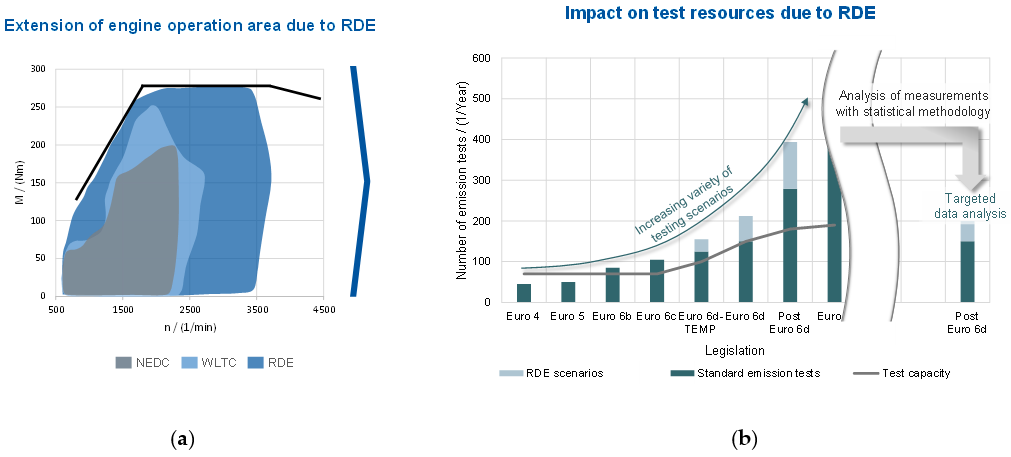
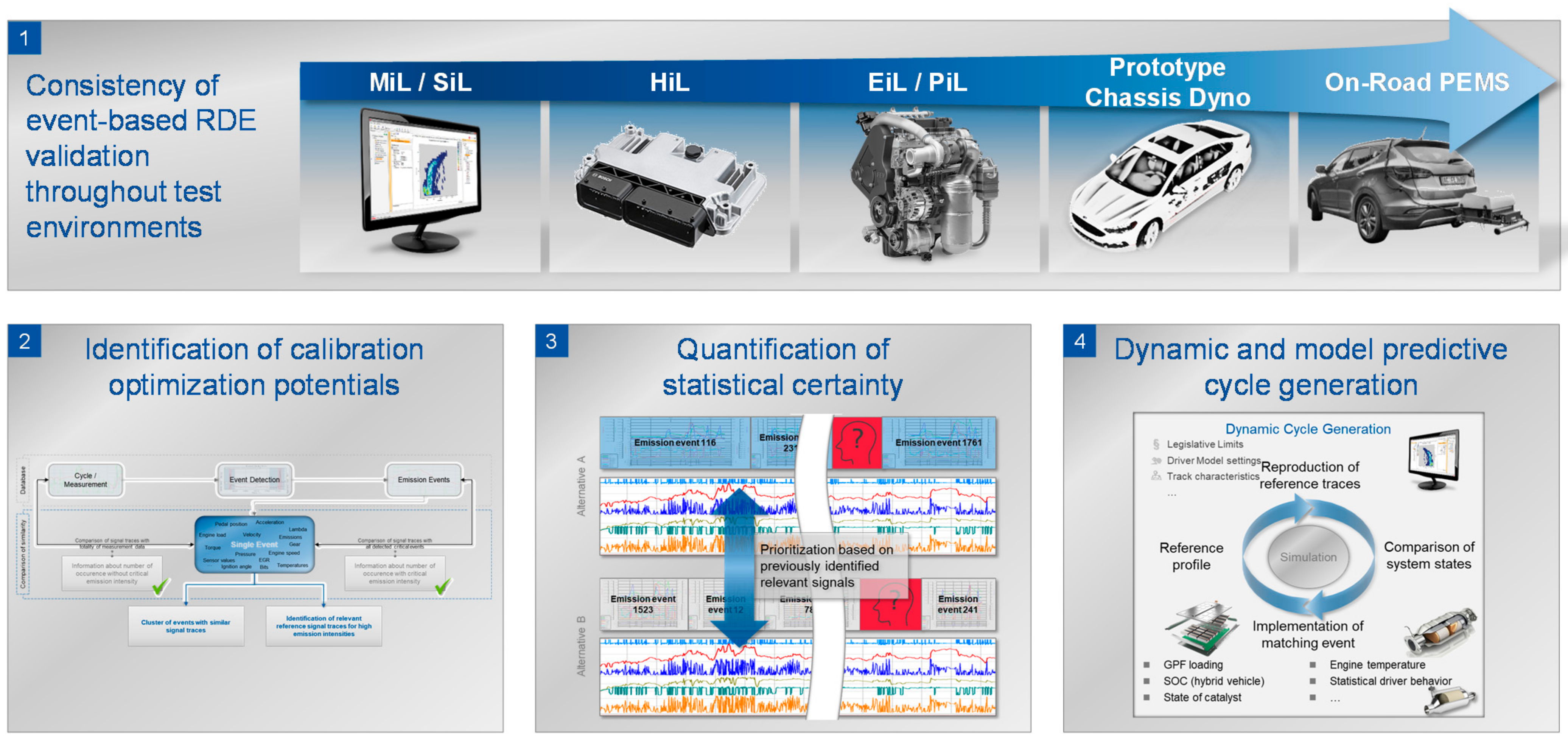
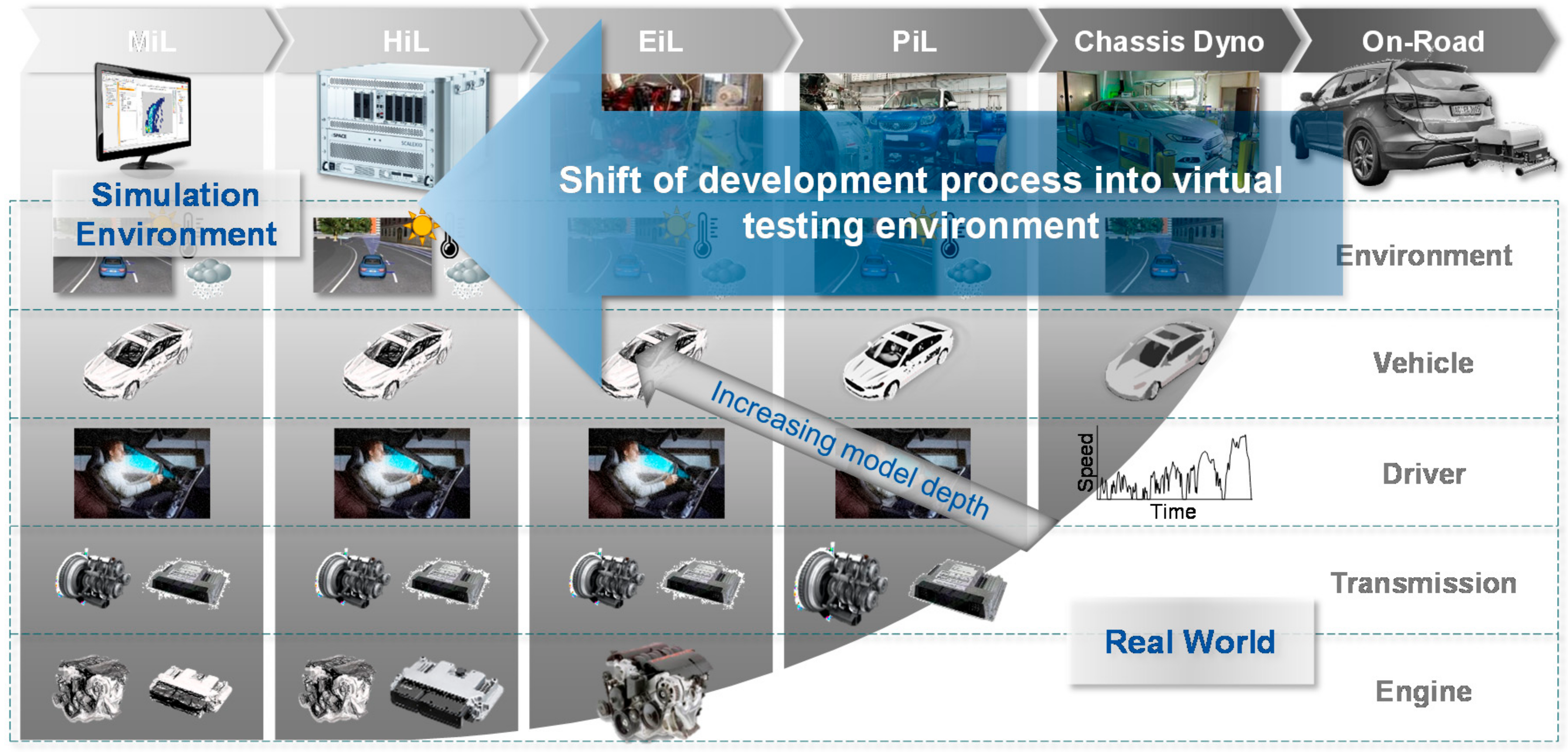
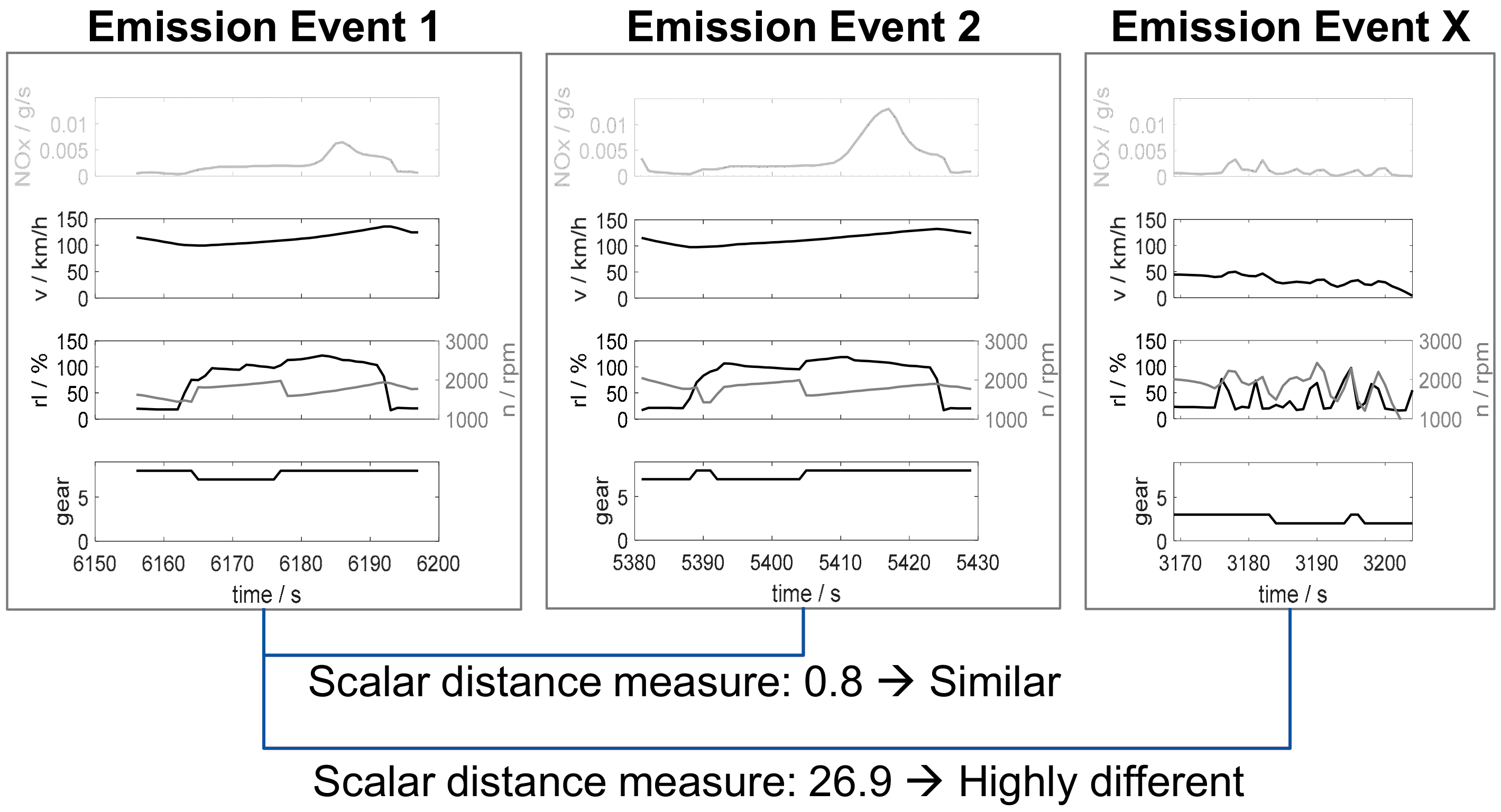
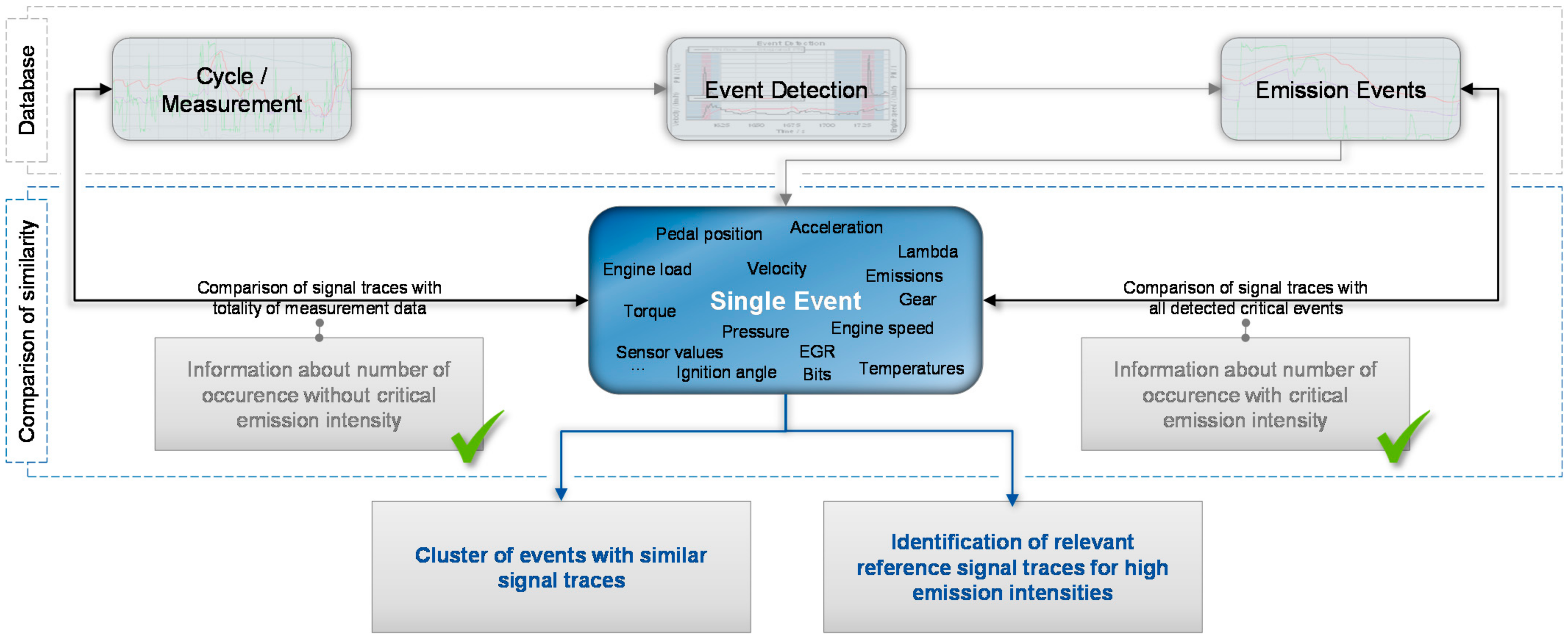

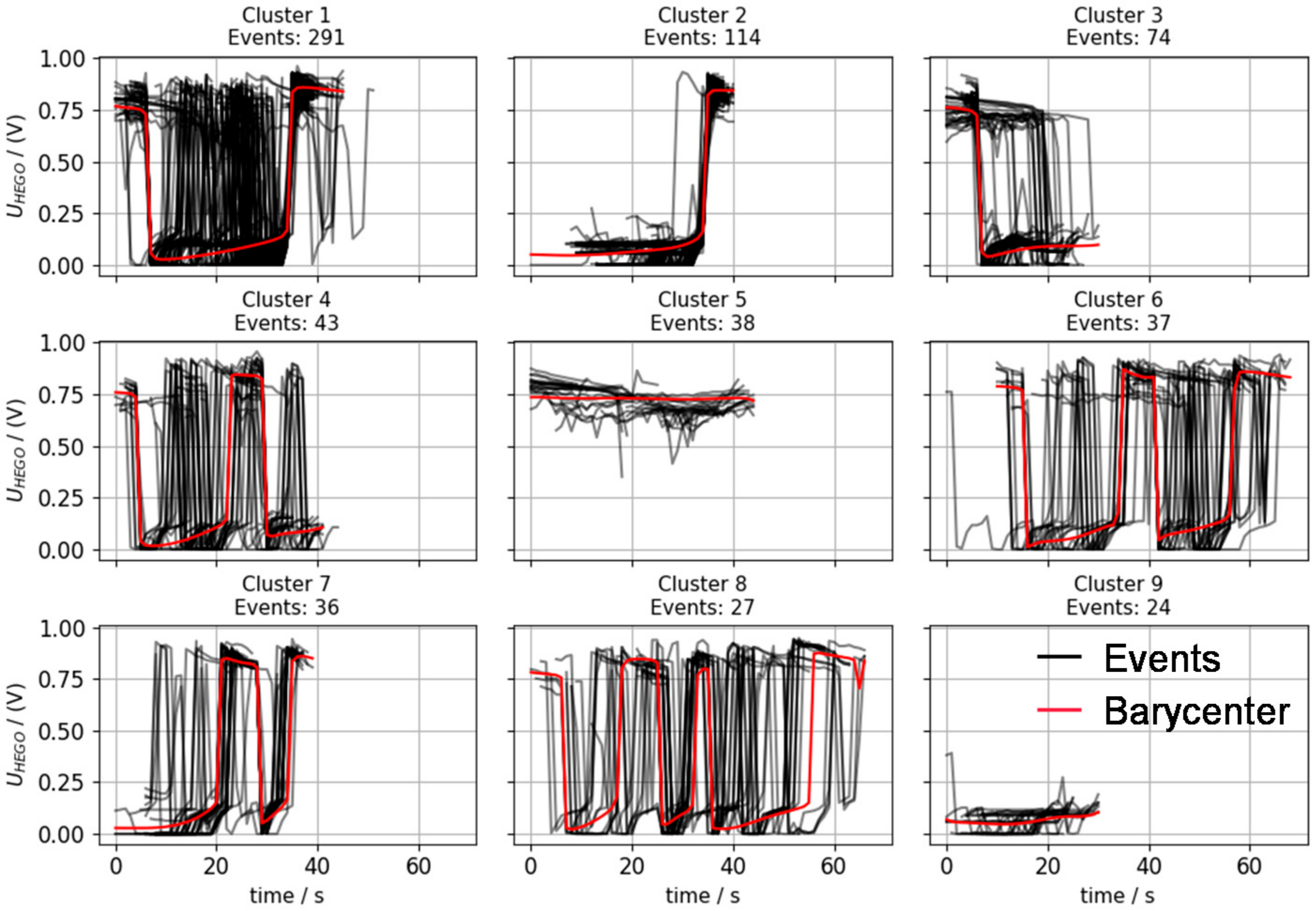
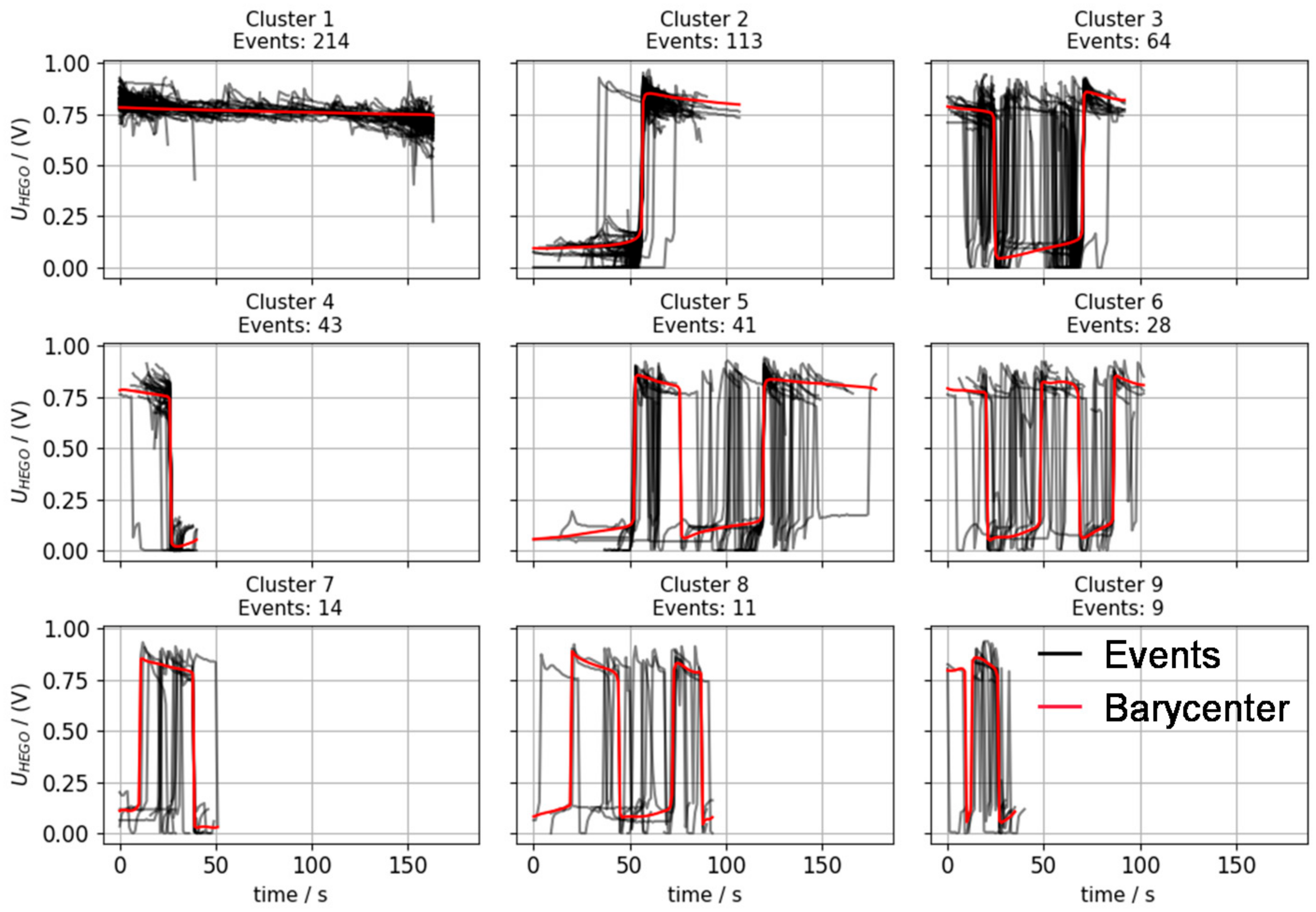
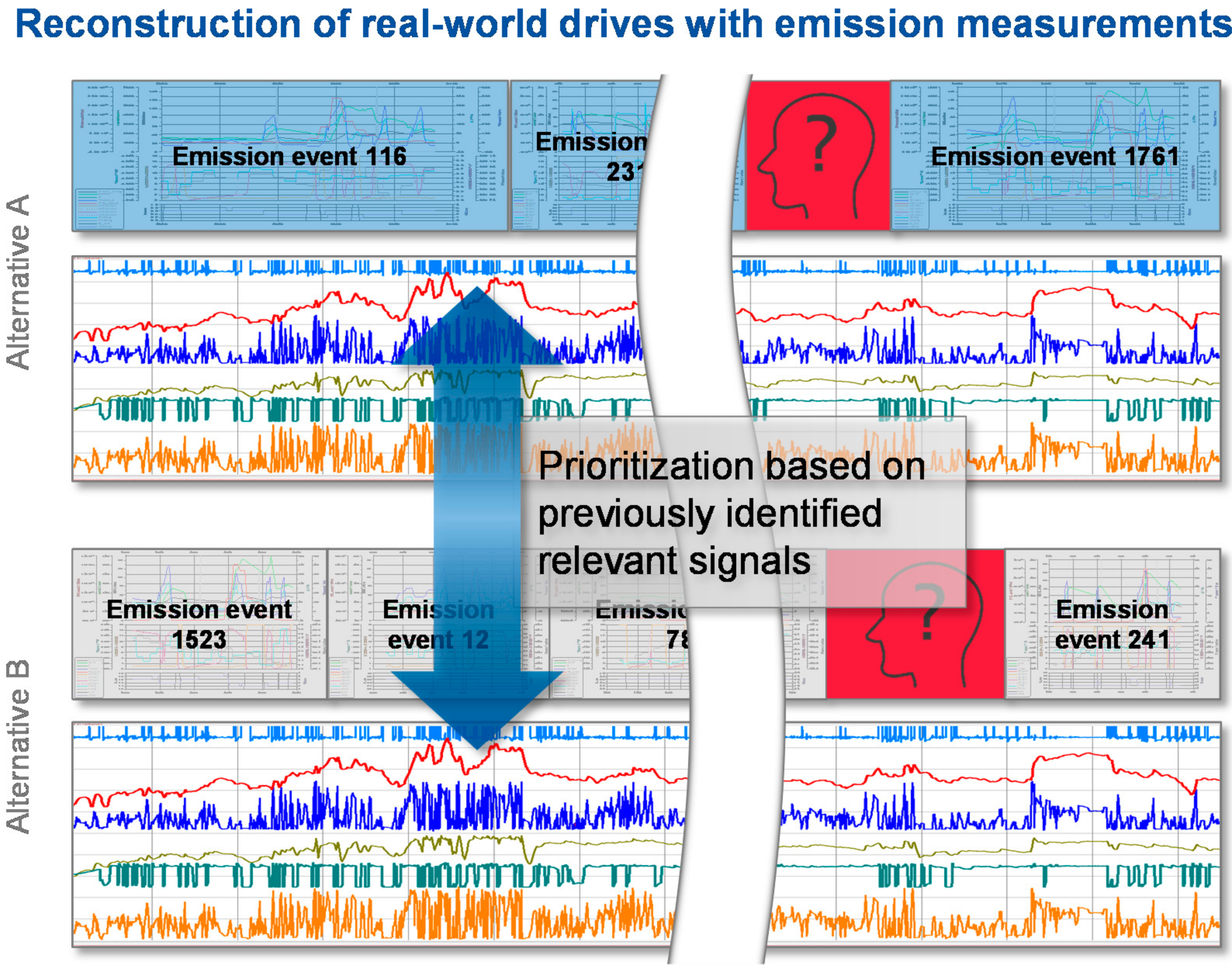
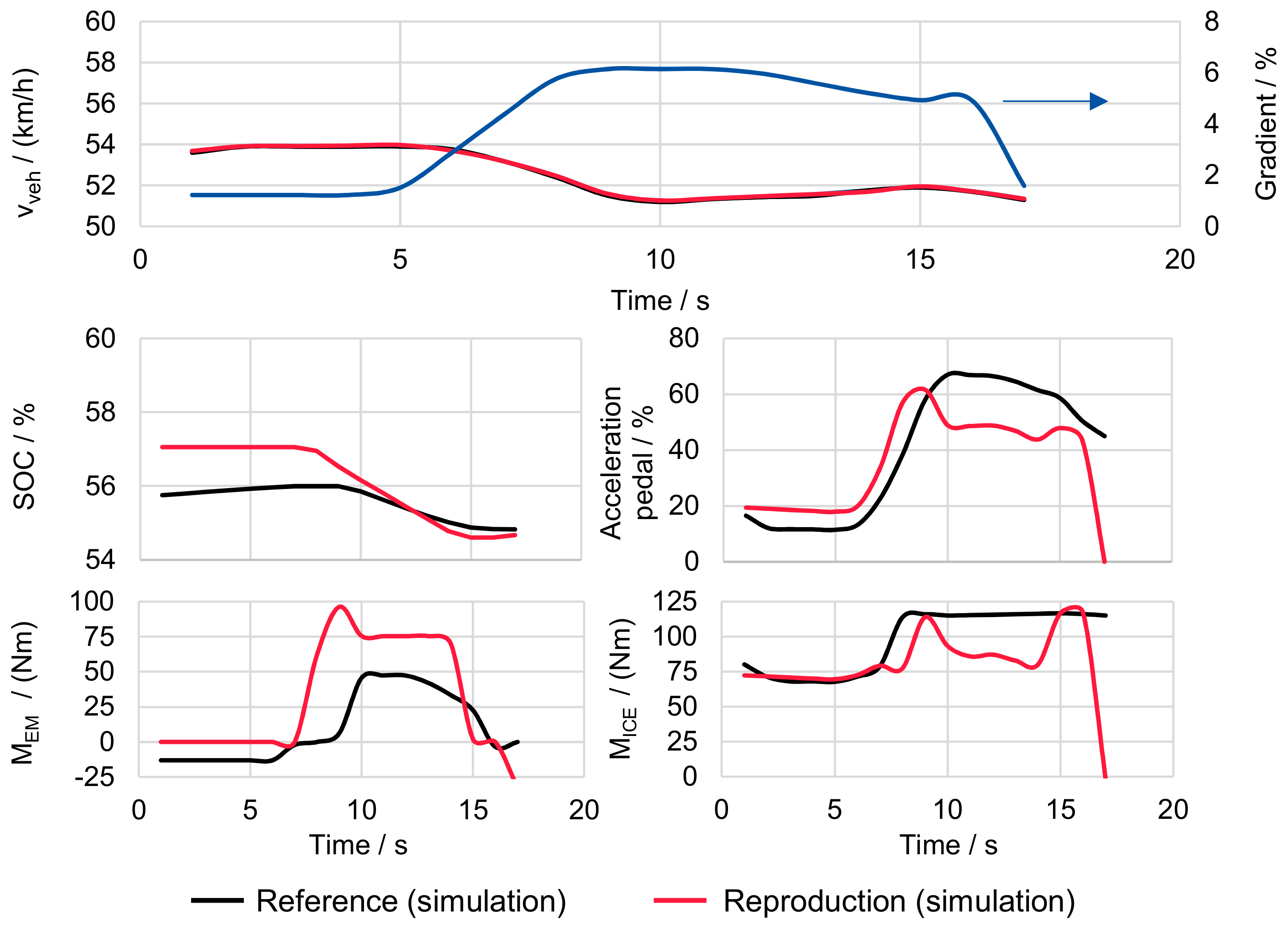
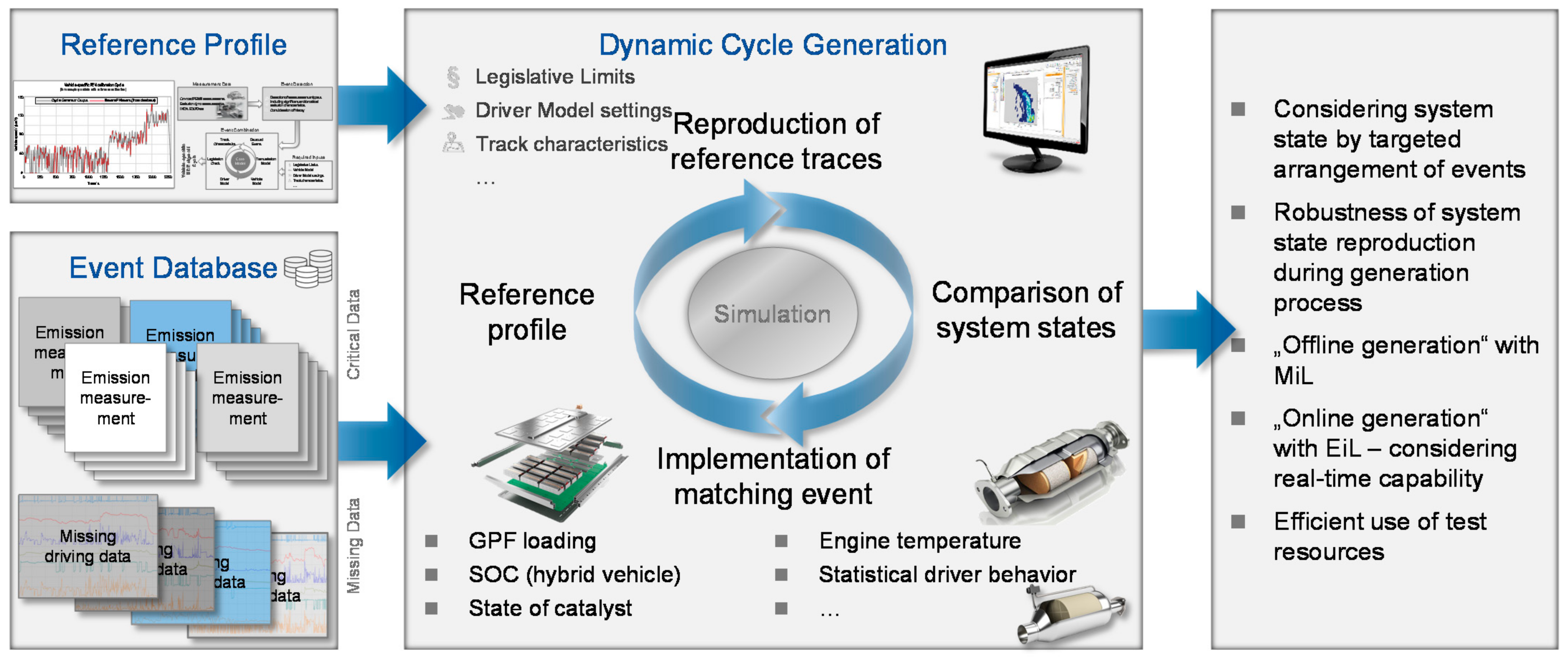
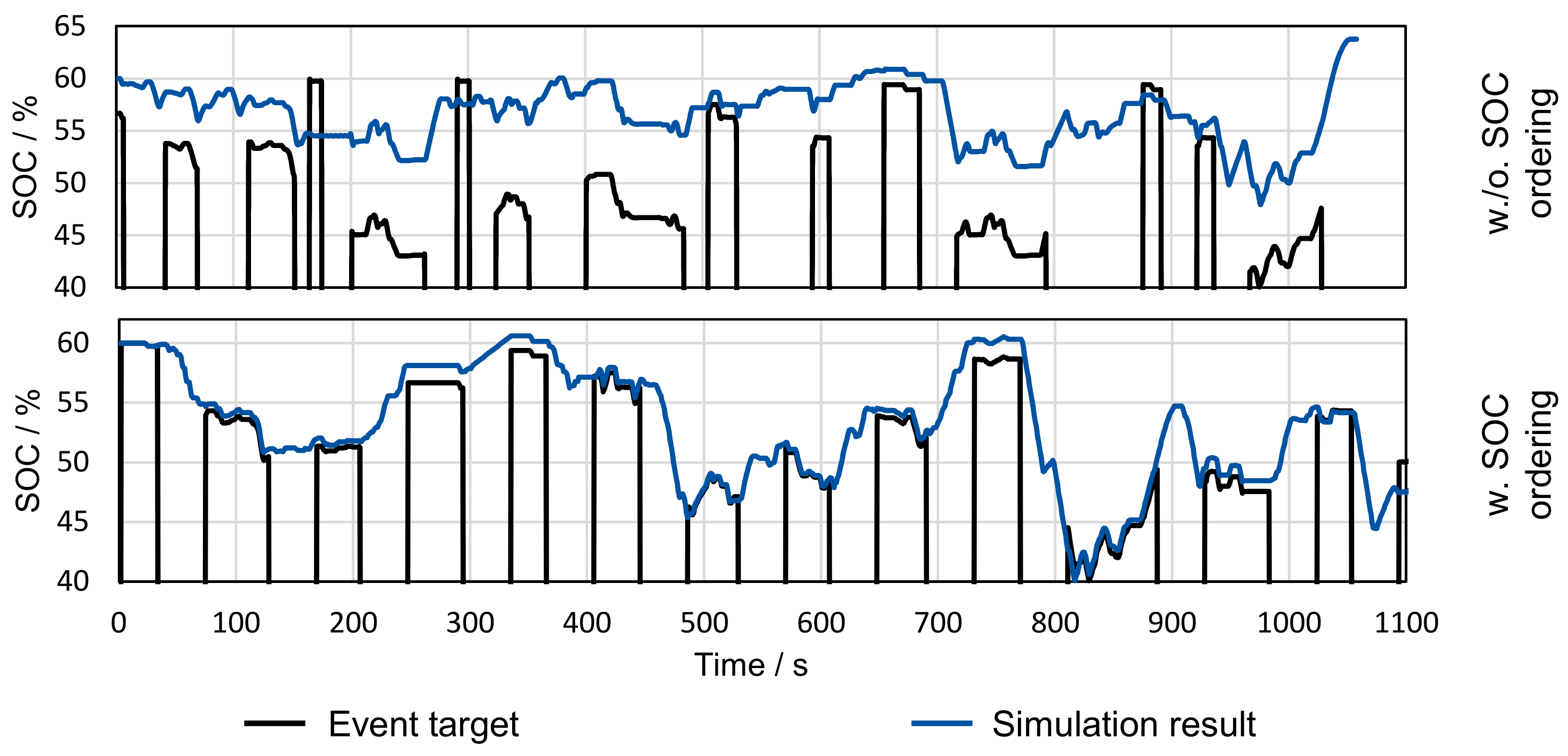
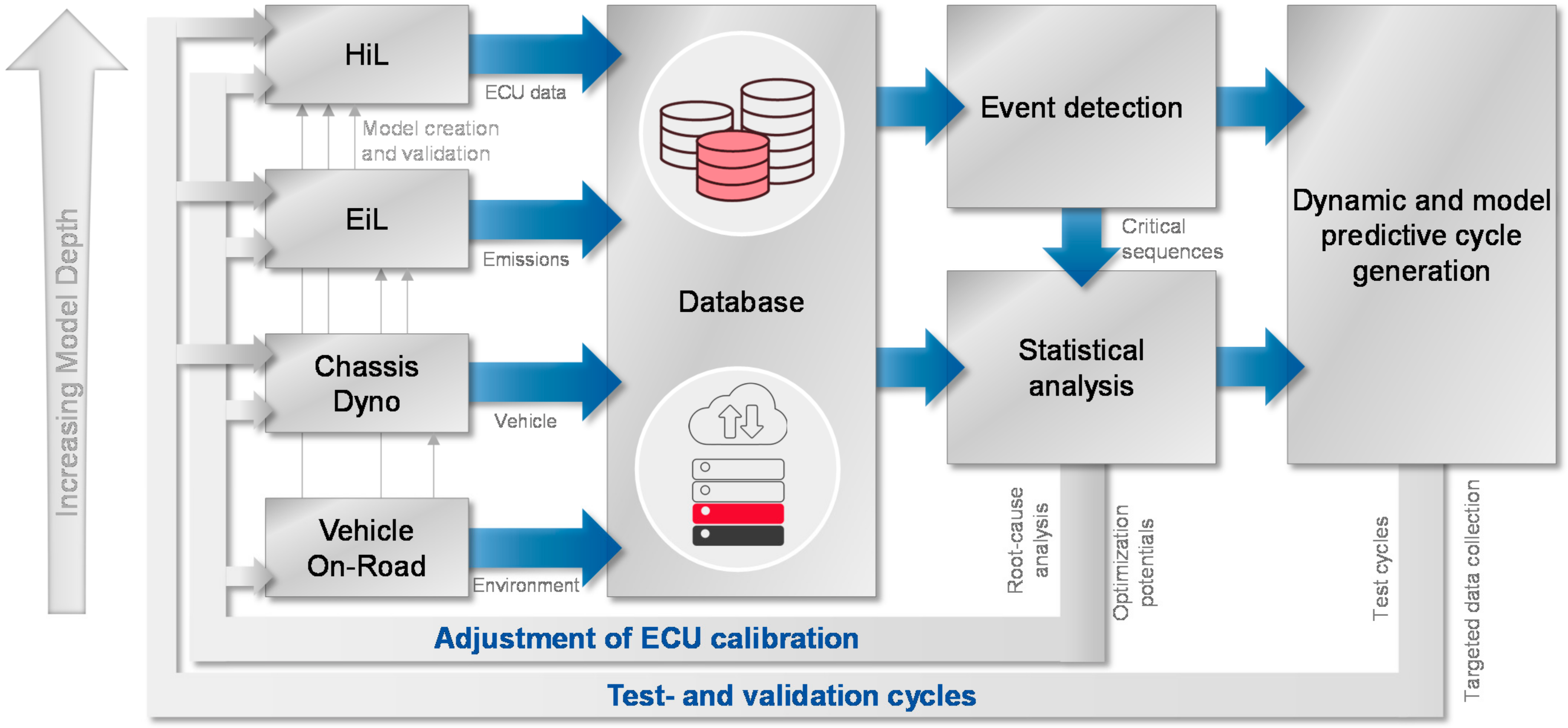

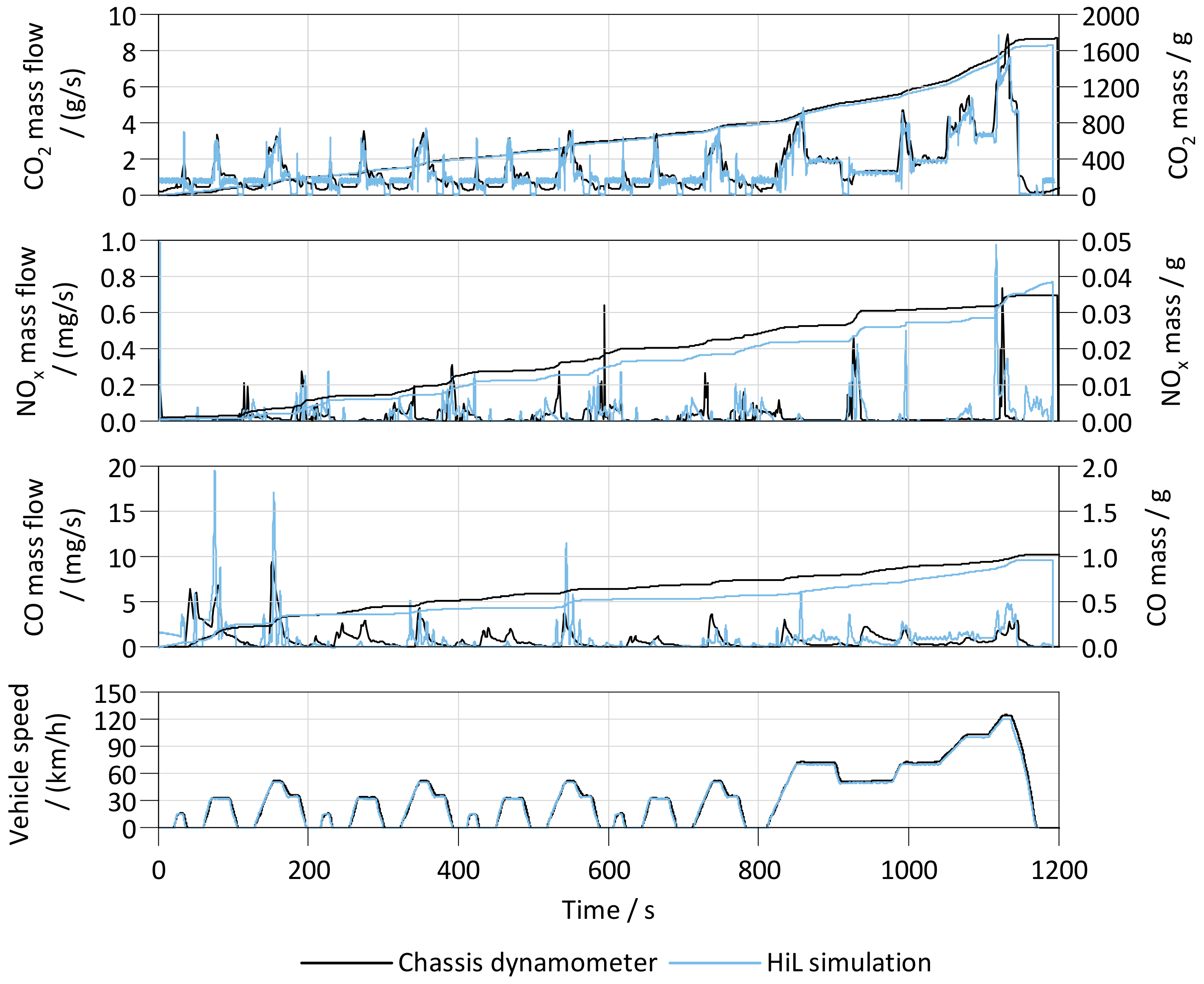
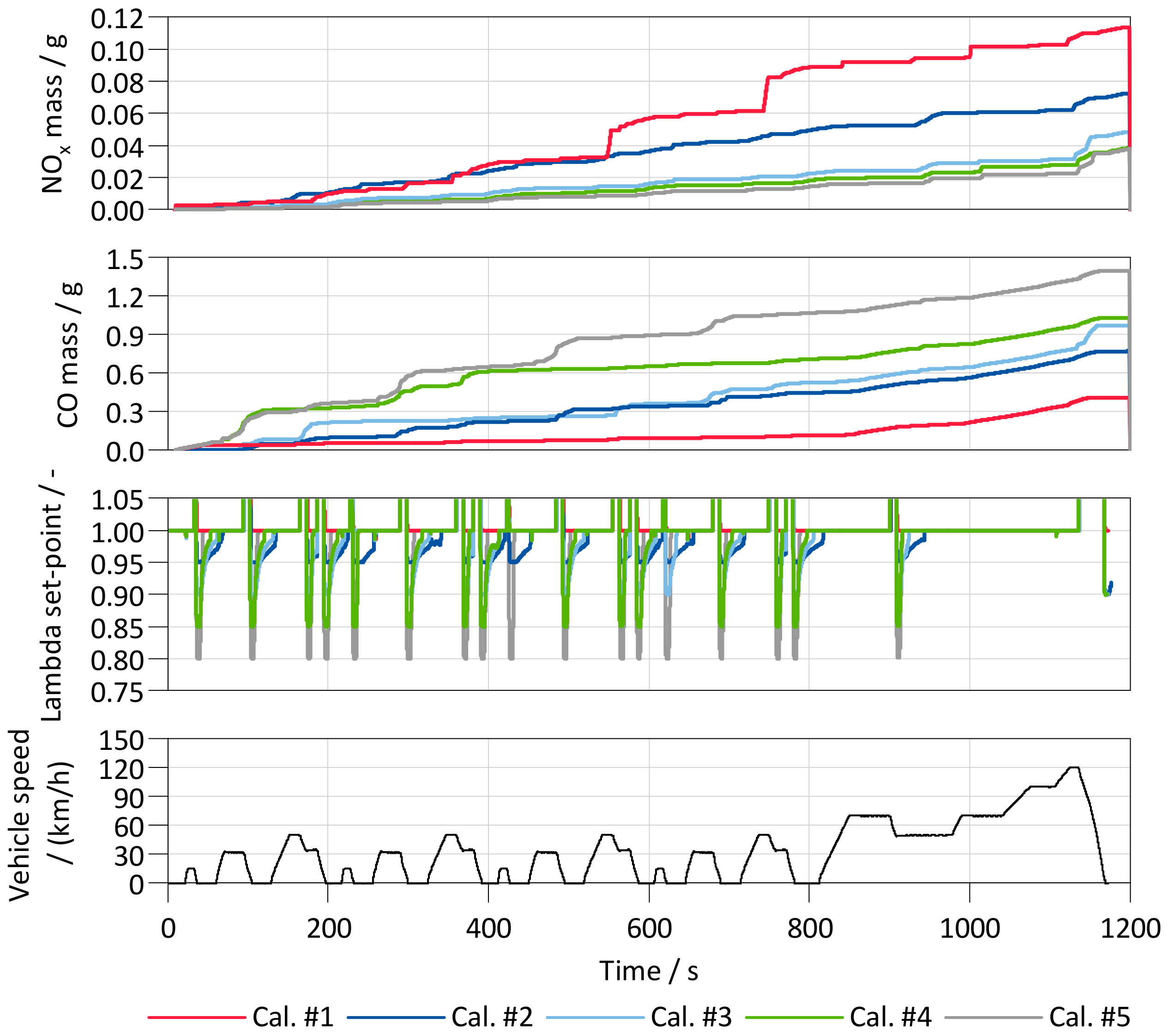
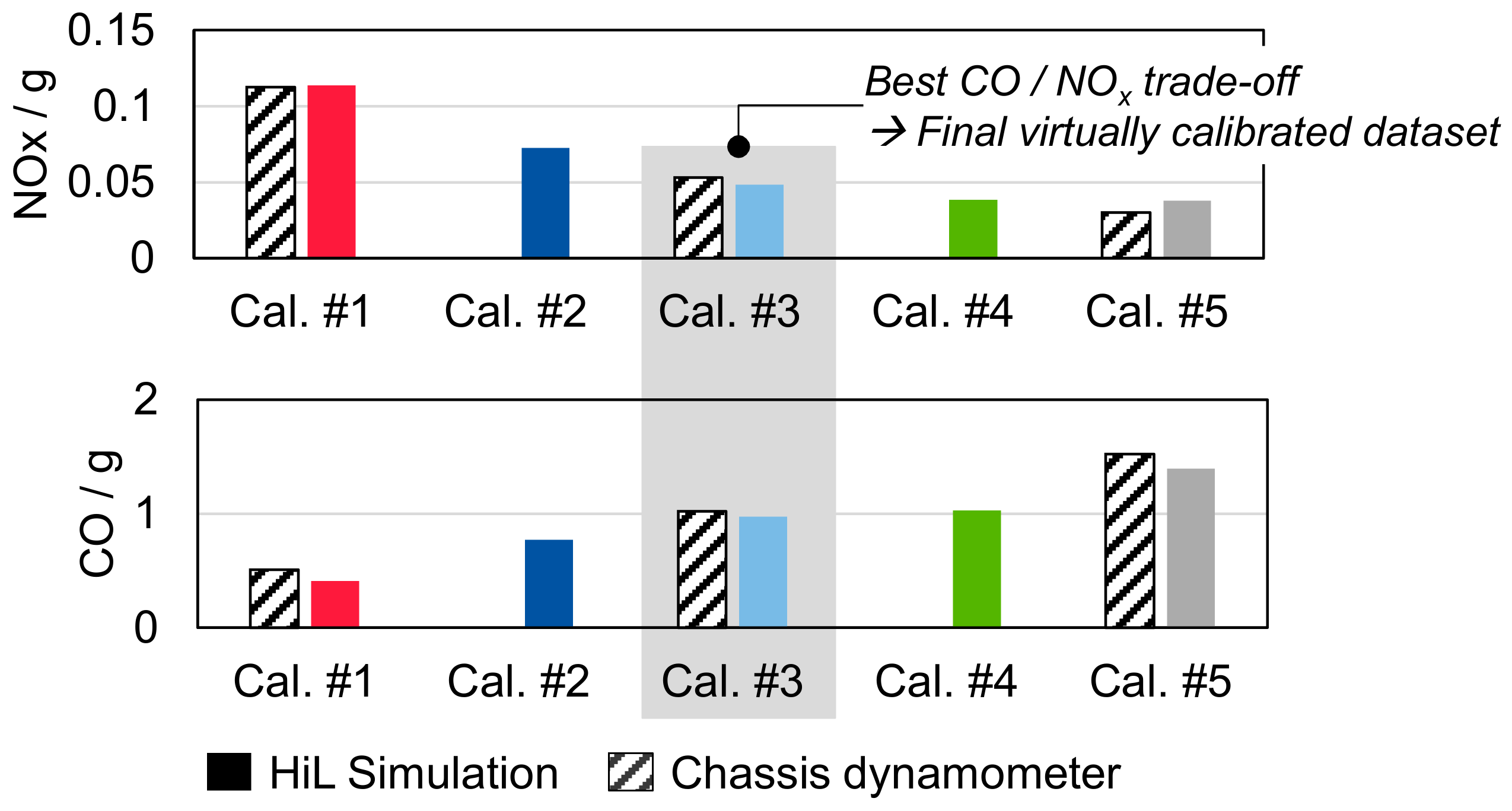
| General Data | ICE | Electric Machine | Battery |
| 1600 kg | 1.5 L turbocharged | 200 Nm | 5.3 Ah/1.4 kWh |
| P2 topology | 4 cylinder gasoline | 30 kW | 270 V |
| 6 speed AT | 177 Nm/94 kW | Rated = max. values | 30–70% opt. range |
| General Data | ICE | EATS |
|---|---|---|
| >1500 kg | 1.5 L turbocharged | TWC |
| Front wheel drive | 4 cylinder gasoline | |
| 8 speed AT | 300 Nm/>150 kW |
Publisher’s Note: MDPI stays neutral with regard to jurisdictional claims in published maps and institutional affiliations. |
© 2021 by the authors. Licensee MDPI, Basel, Switzerland. This article is an open access article distributed under the terms and conditions of the Creative Commons Attribution (CC BY) license (https://creativecommons.org/licenses/by/4.0/).
Share and Cite
Krysmon, S.; Dorscheidt, F.; Claßen, J.; Düzgün, M.; Pischinger, S. Real Driving Emissions—Conception of a Data-Driven Calibration Methodology for Hybrid Powertrains Combining Statistical Analysis and Virtual Calibration Platforms. Energies 2021, 14, 4747. https://doi.org/10.3390/en14164747
Krysmon S, Dorscheidt F, Claßen J, Düzgün M, Pischinger S. Real Driving Emissions—Conception of a Data-Driven Calibration Methodology for Hybrid Powertrains Combining Statistical Analysis and Virtual Calibration Platforms. Energies. 2021; 14(16):4747. https://doi.org/10.3390/en14164747
Chicago/Turabian StyleKrysmon, Sascha, Frank Dorscheidt, Johannes Claßen, Marc Düzgün, and Stefan Pischinger. 2021. "Real Driving Emissions—Conception of a Data-Driven Calibration Methodology for Hybrid Powertrains Combining Statistical Analysis and Virtual Calibration Platforms" Energies 14, no. 16: 4747. https://doi.org/10.3390/en14164747
APA StyleKrysmon, S., Dorscheidt, F., Claßen, J., Düzgün, M., & Pischinger, S. (2021). Real Driving Emissions—Conception of a Data-Driven Calibration Methodology for Hybrid Powertrains Combining Statistical Analysis and Virtual Calibration Platforms. Energies, 14(16), 4747. https://doi.org/10.3390/en14164747






